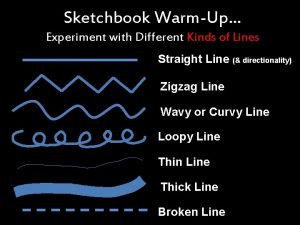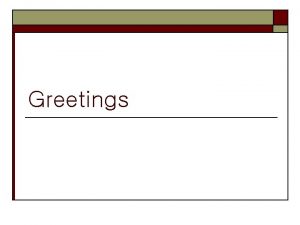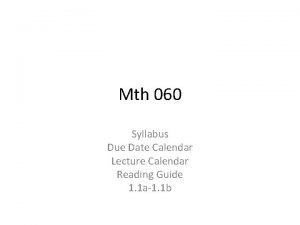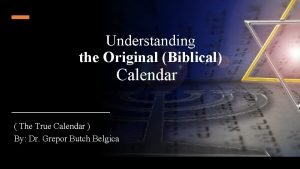Calendar Different kinds of years Different kinds of























































- Slides: 55

Calendar

Different kinds of years

Different kinds of years q The year has been defined generally as the period of apparent revolution of the sun around the earth and is therefore called a `Solar Year'.

Different kinds of years q The year has been defined generally as the period of apparent revolution of the sun around the earth and is therefore called a `Solar Year'. q The year must be in conformity with the occurrence of the seasons and it must be useful for civil purposes.

Different kinds of years q The year has been defined generally as the period of apparent revolution of the sun around the earth and is therefore called a `Solar Year'. q The year must be in conformity with the occurrence of the seasons and it must be useful for civil purposes. We now define three kinds of years.

The sidereal year is the period of revolution of the sun in the ecliptic with reference to any point of the ecliptic. Its durations about 365. 2564 mean solar days. 1.

2. The tropical year is the interval between two successive passages of the sun through the first point of Aries ɣ.

2. The tropical year is the interval between two successive passages of the sun through the first point of Aries ɣ. Due to the phenomenon called precession

2. The tropical year is the interval between two successive passages of the sun through the first point of Aries ɣ. Due to the phenomenon called precession*(Retrograde motion is the apparent motion of a planet in a direction opposite to that of other bodies within its system),

2. The tropical year is the interval between two successive passages of the sun through the first point of Aries ɣ. Due to the phenomenon called precession*(Retrograde motion is the apparent motion of a planet in a direction opposite to that of other bodies within its system), ɣ undergoes a small retrograde motion of about 50’’. 26 per year along the ecliptic.

2. The tropical year is the interval between two successive passages of the sun through the first point of Aries ɣ. Due to the phenomenon called precession*(Retrograde motion is the apparent motion of a planet in a direction opposite to that of other bodies within its system), ɣ undergoes a small retrograde motion of about 50’’. 26 per year along the ecliptic. Therefore the duration of a tropical year is slightly less than a sidereal year.

2. The tropical year is the interval between two successive passages of the sun through the first point of Aries ɣ. Due to the phenomenon called precession*(Retrograde motion is the apparent motion of a planet in a direction opposite to that of other bodies within its system), ɣ undergoes a small retrograde motion of about 50’’. 26 per year along the ecliptic. Therefore the duration of a tropical year is slightly less than a sidereal year. It is about 365. 2422 mean solar days.

2. The tropical year is the interval between two successive passages of the sun through the first point of Aries ɣ. Due to the phenomenon called precession*(Retrograde motion is the apparent motion of a planet in a direction opposite to that of other bodies within its system), ɣ undergoes a small retrograde motion of about 50’’. 26 per year along the ecliptic. Therefore the duration of a tropical year is slightly less than a sidereal year. It is about 365. 2422 mean solar days.

3. The anomalistic year is the interval between two successive passages of the sun through the perigee of its apparent orbit.

3. The anomalistic year is the interval between two successive passages of the sun through the perigee of its apparent orbit. As the perigee has a slow forward motion of about 11”. 25 per year , the anomalistic year is slightly longer than a sidereal year.

3. The anomalistic year is the interval between two successive passages of the sun through the perigee of its apparent orbit. As the perigee has a slow forward motion of about 11”. 25 per year , the anomalistic year is slightly longer than a sidereal year. Its duration is about 365. 2596 mean solar days.

3. The anomalistic year is the interval between two successive passages of the sun through the perigee of its apparent orbit. As the perigee has a slow forward motion of about 11”. 25 per year , the anomalistic year is slightly longer than a sidereal year. Its duration is about 365. 2596 mean solar days.

Civil year, Julian Calendar

Civil year, Julian Calendar None of the three years mentioned above could be used conveniently for ordinary civil purposes as they involve fractions of a day.

Civil year, Julian Calendar None of the three years mentioned above could be used conveniently for ordinary civil purposes as they involve fractions of a day. To avoid this inconvenience the civil year is introduced.

Civil year, Julian Calendar None of the three years mentioned above could be used conveniently for ordinary civil purposes as they involve fractions of a day. To avoid this inconvenience the civil year is introduced. The basis for the civil year is a tropical year and as such the seasons fall at fixed months of the year.

Civil year, Julian Calendar None of the three years mentioned above could be used conveniently for ordinary civil purposes as they involve fractions of a day. To avoid this inconvenience the civil year is introduced. The basis for the civil year is a tropical year and as such the seasons fall at fixed months of the year. The civil year consists of 365 mean solar days for three consecutive years followed by a fourth year of 366 days called leap year.

Civil year, Julian Calendar None of the three years mentioned above could be used conveniently for ordinary civil purposes as they involve fractions of a day. To avoid this inconvenience the civil year is introduced. The basis for the civil year is a tropical year and as such the seasons fall at fixed months of the year. The civil year consists of 365 mean solar days for three consecutive years followed by a fourth year of 366 days called leap year. This system of Reckoning(calculating or estimating) time is due to the Roman Emperor Julius Caesar.

Civil year, Julian Calendar He introduced this system in the year B. C. 45.

Civil year, Julian Calendar He introduced this system in the year B. C. 45. The calendar constructed on these principles is called the Julian calendar.

Civil year, Julian Calendar He introduced this system in the year B. C. 45. The calendar constructed on these principles is called the Julian calendar. According to the Julian calendar, for a leap year, the number denoting the year is a multiple of 4.

Gregorian Calendar

Gregorian Calendar • According to the Julian calendar four civil years exceed four tropical years by about 44 m. 56. 08 s.

Gregorian Calendar • According to the Julian calendar four civil years exceed four tropical years by about 44 m. 56. 08 s. • That is 400 civil years exceed 400 tropical years by about 3 days 2 hours 53 minutes 20 seconds.

Gregorian Calendar • According to the Julian calendar four civil years exceed four tropical years by about 44 m. 56. 08 s. • That is 400 civil years exceed 400 tropical years by about 3 days 2 hours 53 minutes 20 seconds. • It is essential that this difference must be compensated, otherwise the civil year won’t mark the recurrence of seasons(Spring, Summer, Autumn and Winter) in the long run.

Gregorian Calendar • According to the Julian calendar four civil years exceed four tropical years by about 44 m. 56. 08 s. • That is 400 civil years exceed 400 tropical years by about 3 days 2 hours 53 minutes 20 seconds. • It is essential that this difference must be compensated, otherwise the civil year won’t mark the recurrence of seasons(Spring, Summer, Autumn and Winter) in the long run. • Therefore in the year 1582 A. D. , Pope Gregory XIII introduced a correction to the Julian Calendar. According to him a year whose number is a multiple of 100 is not a leap year unless the number denoting the century is a multiple of 4.

Gregorian Calendar • According to the Julian calendar four civil years exceed four tropical years by about 44 m. 56. 08 s. • That is 400 civil years exceed 400 tropical years by about 3 days 2 hours 53 minutes 20 seconds. • It is essential that this difference must be compensated, otherwise the civil year won’t mark the recurrence of seasons(Spring, Summer, Autumn and Winter) in the long run. • Therefore in the year 1582 A. D. , Pope Gregory XIII introduced a correction to the Julian Calendar. According to him a year whose number is a multiple of 100 is not a leap year unless the number denoting the century is a multiple of 4. • The calendar constructed on this principle is called the Gregorian Calendar.

Gregorian Calendar • This calendar is now in force. According to this calendar 1900 A. D, is not a leap year whereas 2000 AD is a leap year.

Gregorian Calendar • This calendar is now in force. According to this calendar 1900 A. D, is not a leap year whereas 2000 AD is a leap year. • Even the Gregorian system of reckoning time is not prefect for according to this, 4000 civil years exceed 4000 tropical years by about 1 day 4 hours and 55 minutes. This requires further correction.

Julian date

Julian date • The Julian date has no connection with Julius Caesar.

Julian date • • The Julian date has no connection with Julius Caesar. In the year 1582 A. D, Joseph Scaliger introduced a new mode of reckoning time for the purpose of astronomical calculations. He called after his father’s name Julius.

Julian date • The Julian date has no connection with Julius Caesar. • In the year 1582 A. D, Joseph Scaliger introduced a new mode of reckoning time for the purpose of astronomical calculations. He called after his father’s name Julius. • The starting point or epoch for the system is the mean noon of Jan. 1, 4713 B. C.

Julian date • The Julian date has no connection with Julius Caesar. • In the year 1582 A. D, Joseph Scaliger introduced a new mode of reckoning time for the purpose of astronomical calculations. He called after his father’s name Julius. • The starting point or epoch for the system is the mean noon of Jan. 1, 4713 B. C. • The Julian date on any given day is the number of mean solar days that have elapsed since Jan. 1, 4713 B. C.

Julian date • The Julian date has no connection with Julius Caesar. • In the year 1582 A. D, Joseph Scaliger introduced a new mode of reckoning time for the purpose of astronomical calculations. He called after his father’s name Julius. • The starting point or epoch for the system is the mean noon of Jan. 1, 4713 B. C. • The Julian date on any given day is the number of mean solar days that have elapsed since Jan. 1, 4713 B. C. • The Nautical Almanac (An almanac (also spelled almanack and almanach) is an annual publication that includes information such as weather forecasts, farmers' planting dates, tide tables, and tabular information often arranged according to the calendar)gives the Julian date for every day of the year.

Julian date • The day of the week corresponding to a given Julian date can be found by dividing the J. D. by 7.

Julian date • The day of the week corresponding to a given Julian date can be found by dividing the J. D. by 7. The remainder 0 gives Monday. 1 gives Tuesday. 2 gives Wednesday and so on.

Julian date • The day of the week corresponding to a given Julian date can be found by dividing the J. D. by 7. The remainder 0 gives Monday. 1 gives Tuesday. 2 gives Wednesday and so on. • The Julian dates are very useful for recording the dates of eclipses.

Julian date • The day of the week corresponding to a given Julian date can be found by dividing the J. D. by 7. The remainder 0 gives Monday. 1 gives Tuesday. 2 gives Wednesday and so on. • The Julian dates are very useful for recording the dates of eclipses. • If the Julian date of occurrence of an eclipse be x , an eclipse of the same kind occurs on the Julian date x+6585*. •

Julian date • The day of the week corresponding to a given Julian date can be found by dividing the J. D. by 7. The remainder 0 gives Monday. 1 gives Tuesday. 2 gives Wednesday and so on. • The Julian dates are very useful for recording the dates of eclipses. • If the Julian date of occurrence of an eclipse be x , an eclipse of the same kind occurs on the Julian date x+6585*. • Julian dates are also used for observations related to variable stars.

PROBLEM The Nautical Almanac gives the Julian date of Jan. 1, 1940 as 2429630. Find the J. D of Jan 26, 1965 and the day of the week.

PROBLEM The Nautical Almanac gives the Julian date of Jan. 1, 1940 as 2429630. Find the J. D of Jan 26, 1965 and the day of the week. Solution: J. D. of Jan 1, 1940 is 2429630.

PROBLEM The Nautical Almanac gives the Julian date of Jan. 1, 1940 as 2429630. Find the J. D of Jan 26, 1965 and the day of the week. Solution: J. D. of Jan 1, 1940 is 2429630. J. D. of Jan 1, 1965 is 2429630+365× 25+7 = 2429630+9125+7 = 2438762.

PROBLEM The Nautical Almanac gives the Julian date of Jan. 1, 1940 as 2429630. Find the J. D of Jan 26, 1965 and the day of the week. Solution: J. D. of Jan 1, 1940 is 2429630. J. D. of Jan 1, 1965 is 2429630+365× 25+7 LEAP YEAR = 2429630+9125+7 TOTAL NUMBER OF DAYS IN THE YEAR = 2438762.

PROBLEM The Nautical Almanac gives the Julian date of Jan. 1, 1940 as 2429630. Find the J. D of Jan 26, 1965 and the day of the week. Solution: J. D. of Jan 1, 1940 is 2429630. J. D. of Jan 1, 1965 is 2429630+365× 25+7 LEAP YEAR = 2429630+9125+7 TOTAL NUMBER OF DAYS IN THE YEAR = 2438762. J. D. of Jan 26, 1965 is 2438762.

PROBLEM The Nautical Almanac gives the Julian date of Jan. 1, 1940 as 2429630. Find the J. D of Jan 26, 1965 and the day of the week. Solution: J. D. of Jan 1, 1940 is 2429630. J. D. of Jan 1, 1965 is 2429630+365× 25+7 LEAP YEAR = 2429630+9125+7 TOTAL NUMBER OF DAYS IN THE YEAR = 2438762. J. D. of Jan 26, 1965 is 2438762. When divided by 7, the remainder is 1.

PROBLEM The Nautical Almanac gives the Julian date of Jan. 1, 1940 as 2429630. Find the J. D of Jan 26, 1965 and the day of the week. Solution: J. D. of Jan 1, 1940 is 2429630. J. D. of Jan 1, 1965 is 2429630+365× 25+7 LEAP YEAR = 2429630+9125+7 TOTAL NUMBER OF DAYS IN THE YEAR = 2438762. J. D. of Jan 26, 1965 is 2438762. When divided by 7, the remainder is 1. Therefore the day is Tuesday.

Besselian Year • A new mode of reckoning tropical year was introduced by the German astronomoer Bessel. • According to him the tropical year is taken to begin when the R. A of mean sun (or the mean longitude of the sun) is exactly 280˚. • This instant very nearly coincides with the beginning of the civil year*. • The year thus reckoned is called the Besselian year. • Its length is same as that of the tropical year. • The beginning of any Besselian year is indicated by writing. 0 after the number denoting the year. Thus 1965. 0 means the beginning of the Besselian year 1965. • Besselian year is very useful for any astronomical calculations.


V. Vairaperumal, Department of Mathematics, St. Joseph’s College(Autonomous), Tiruchirappalli – 620 002.
 Julian calendar 2019
Julian calendar 2019 300 solar years to lunar years
300 solar years to lunar years How long ago was four score and seven years
How long ago was four score and seven years Sheep years to human years
Sheep years to human years You can easily forget how different life was 50 years ago.
You can easily forget how different life was 50 years ago. Active participation strategies
Active participation strategies Different types of roots
Different types of roots Different kinds of graphs
Different kinds of graphs Kinds of sports
Kinds of sports Different types of bar graphs
Different types of bar graphs Types of media
Types of media Different kinds of choral speaking
Different kinds of choral speaking There are many kinds of sport
There are many kinds of sport What are the examples of claim of value
What are the examples of claim of value The four types of paragraphs
The four types of paragraphs Different kinds of lines
Different kinds of lines Different kinds of shops
Different kinds of shops Types of charachters
Types of charachters Polygon 5 sides
Polygon 5 sides What are the 7 pronouns?
What are the 7 pronouns? Different kinds of greetings
Different kinds of greetings Different kinds of lines
Different kinds of lines Indirect speech act example
Indirect speech act example What do landforms look like
What do landforms look like Laxative classification
Laxative classification Different kinds of dashes
Different kinds of dashes Patterns of development in writing comparison and contrast
Patterns of development in writing comparison and contrast How many types of sports
How many types of sports Pros of traditional economy
Pros of traditional economy What are the 4 types of printmaking techniques?
What are the 4 types of printmaking techniques? Hombuses
Hombuses How many kinds of letter are there
How many kinds of letter are there Whole shellfish
Whole shellfish Market forms and cuts of meat
Market forms and cuts of meat Different kinds of maps
Different kinds of maps Cause and effect in patterns of development
Cause and effect in patterns of development Different kind of choral speaking
Different kind of choral speaking Journalism headline examples
Journalism headline examples Greek love
Greek love Descriptive correlational research design
Descriptive correlational research design Sound will travel at different speeds in different mediums.
Sound will travel at different speeds in different mediums. Different angle different story
Different angle different story Venn diagram different same different
Venn diagram different same different Lrefraction
Lrefraction Acid base song
Acid base song Why do different polymers have different properties
Why do different polymers have different properties Different materials have different
Different materials have different Cultural relativism
Cultural relativism Flame test principle
Flame test principle We are all different but the same
We are all different but the same Historians tools
Historians tools Fau grade forgiveness
Fau grade forgiveness Aish com calendar
Aish com calendar Natural family planning calendar
Natural family planning calendar Lent calendar 2019
Lent calendar 2019 Unsw hdr calendar
Unsw hdr calendar















































































